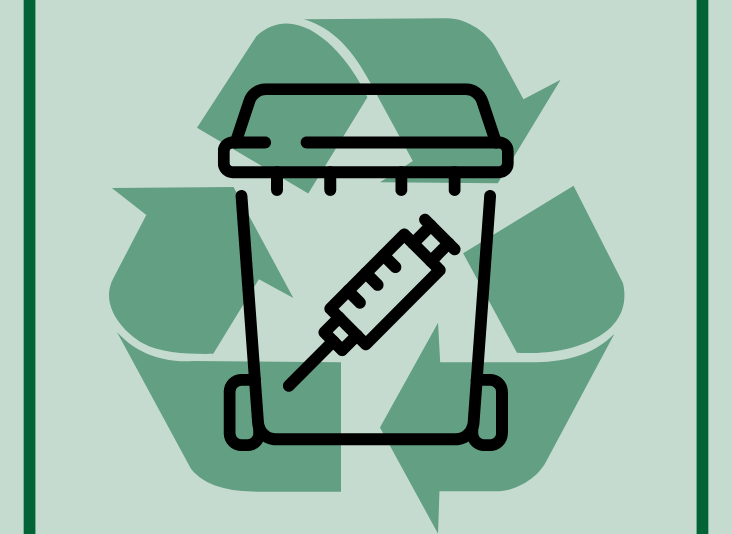Reuse for Your Recycling: 3+ Benefits of Reusable Regulated Waste Containers
The United States produces an annual 268 million tons of waste; of that, 140 million tons ends up in a landfill. Healthcare facilities alone generate 6,600 metric tons per day. This waste is an ever-growing problem, and one that is exacerbated by the difficulty of collection.
Traditionally, in-lab waste collection involves storing waste in single-use regulated waste containers before it is transported off site. These containers are a necessity for waste management in healthcare, life sciences, and other industries, as they protect employees from injury and contain waste in a localized zone.
Typically, however, these containers can only be used once, and are destined for the landfill after only a brief useful life. This is a tremendous waste of money, energy, and recoverable material—and contributes to an outdated, throwaway, and environmentally-destructive system.
Reusable Regulated Waste Containers: A Viable Alternative
Reliance on single-use container disposal methods is widespread for a reason; many perceive it as being safer, more compliant, and more cost-effective than a bin that is reusable. Managers, particularly those in healthcare or life science, naturally assume they must factor in special compliance and safety considerations when reusing any object in the waste lifecycle.
These questions are frequently raised:
- Are reusable containers disinfected thoroughly and properly?
- Are reusables compliant with local and federal regulations?
- Will reusables enable me to save money and meet my bottom line?
- Am I—and my employees, clients, and community—going to remain safe if I choose to use reusables?
The good news is that waste disposal and collection options and systems exist that allow facility workers to reuse their regulated waste collection containers. Such systems meet all essential requirements, and enable:
- Safety
- Convenience
- Compliance
- Sustainability
- Worry-free operations
(Basically) The Same Process—Better Results
Traditionally, red regulated waste containers are mounted on the wall or otherwise stored securely. They are used as normal and, when full, they are discarded alongside the waste—typically in a landfill. Unfortunately, this entire process can have negative implications for return on investment (ROI), sustainability, and other worthwhile initiatives or objectives.
The reusable regulated waste container process, however, allows waste receptacles to be used again and again—avoiding completely the negative impacts of the single-use container lifecycle. To fully understand this, we must first look at the reusables process:
- Waste containers are delivered on-site and used as normal. (Staff and management enjoy the benefits we will discuss below.)
- Containers are removed and transported to our facility in Jeannette, Pennsylvania. All reusable containers are designed for transport and thus can be safely and efficiently loaded onto trucks.
- Containers are disinfected according to guidelines from the Pennsylvania Department of Environmental Protection (PADEP).
- Waste containers are nested together and redistributed to other participating facilities.
- The containers are used, benefits are enjoyed, and the process repeats continually.
Depending on the container type, each container can be reused over 400 times, the maximum amount allowed by the Food and Drug Administration (FDA), without compromising safety and compliance. On average, in normal operating conditions, our containers last up to 350 full cycles, or roughly 4.5 years.
Multitude of Reusable Waste Container Benefits
Despite this, you may still ask: “Why should I bother to switch to reusables? Since the disposal process is the same, why should I care to change?” The fact is, reusable waste containers can enable numerous tempting benefits—that apply to almost every aspect of operations.
These benefits include:
1. Saved Time, Salvaged ROI, and Improved Operational Efficiency
Let’s face it—the cost of a waste container will always be a necessity. There’s no way to get these crucial waste containers for free. So, if you are going to be incurring this cost no matter what, why not do so in a way where, over the long term, you get some of your money back (and see some other benefits, too)? Here are four convincing reasons why reusable waste containers are more cost effective:
- Operational efficiencies—the same amount of employees can accomplish more, in less time. By eliminating the need to exchange sharps or perform other single-use container-specific tasks, team members can instead focus their efforts on more essential, core tasks.
- When disposable waste containers are needed, so is continuous purchasing. Adopting a reusable container model means there is a single upfront investment, or maybe even included in your contract—and then very rare replenishment afterward. That results in less paperwork, accounting headaches, and administrative effort.
- Reusable containers tend to be built to allow for increased durability—they last longer and are virtually malfunction-free. Operations are less likely to be disrupted by their damage. Single-use containers, with only one lifecycle, are more fragile—as such, even though they are only used once, they are more liable to damage. This can result in increased worker injury and more frequent replacement or repair—which can add up.
- When reusables are constructed in the correct way, they can support compliant processes that protect employees. More than 90% of sharps injuries are related to container design; thick reusable containers are proven to reduce needlestick injuries, which can help employees work more confidently and accurately, improving speed and efficiency as a result.
Let’s look at this on a cost basis. Let’s assume you spend $100 on disposal containers annually (which is a very low estimate). You may be able to reduce that by 30% when opting for a reusable program, lowering costs and saving you thousands in the long run. And if you have even one needlestick per year, that will run you over $4,300 on average—switching to a safer, more durable container will eliminate that injury cost outright.
In fact, our implementation of reusable sharps container programs has yielded client savings of more than $20 million per year. These are the kinds of cost containment efforts that boost ROI and fatten the organization’s overall bottom line.
2. Safe, Compliant Operations That Burnish the Brand Image
Reusable containers are just as compliant as their disposable counterparts. Properly handled, reusable regulated waste containers support safe operations that protect employees and eliminate the risk of noncompliance—as well as associated penalties. And considering that noncompliance fines can run to $16,131 per violation, compliance can also be a significant cash savings.
Such containers, because of their design and structural strength, are also less likely to cause worker injury, as discussed above. Safety compliance is not only better for employees, but it also supports a good brand image and reputation. Being a compliant employer is a great incentive to attract and retain the best team members—and not only that, but clients always prefer to do business with a trustworthy, responsible company that follows best practices to protect its people and the overall environment.
3. Improved Sustainability
In recent years, sustainability has become a hot topic—and those organizations that don’t prioritize green practices implementation are falling behind. Single-use waste containers themselves are also usually made of plastic, and, if improperly disposed of, can cause further environmental degradation and destruction. So, when it comes to implementing organizational sustainability initiatives, reusable container solutions are low-hanging fruit.
In short, this system is more sustainable because it saves material from the landfill. Any product or substance, especially if it is only used once, diverted from the (typically) unsustainable landfill is a win for the planet. In fact, according to a study published in the National Library of Medicine (NLM), one hospital was able to curtail over 50 tons of plastic and more than 8 tons of cardboard from their common waste streams.
While reusables do require thorough cleaning (and thus, water and/or disinfectant), the overall environmental cost of that is almost nonexistent in comparison—disinfection’s contribution to global warming potential is low.
There is also a proven carbon footprint reduction from using reusable containers. Carbon dioxide (CO2) is a potent greenhouse gas that harms human health and the environment—and the more emissions are reduced, the better. Based on the same study referenced above, switching from disposable to reusable containers saved 162.4 metric tons of CO2 over the lifespan of the container.
Let’s dig into this a bit:
- Traditional waste container systems produce the bulk of their carbon footprint in the manufacturing stage. Since reusable containers undergo this manufacturing process only once, that means immense energy savings. The NLM case study, for example, found that the use of reusable containers meant 47 times less CO2 equivalent emissions (CO2e) over the life of each container.
- Reusable waste containers are designed for easy and efficient transport, maximizing the amount of containers that can be included in just one truckload. This reduces greenhouse gas (GHG) emissions per container—and thus, maximizes eco-friendliness. In fact, when factoring in all elements of a reusable containers lifecycle, including transportation, reusables demonstrate an 84% reduction in GHG emissions.
- At the end of its useful life, a reusable container tends to be recycled instead of landfilled. This means, it can thus be turned into another great product that extends ROI and reduces 10.2 tons of CO2e per container. Disposal containers do not reduce CO2e and just end up taking up space in a landfill.
Overall, it has been proven that switching to reusable containers is more environmentally friendly; reusable containers save CO2e and prevent environmentally-costly incineration or landfilling of plastic and cardboard.
Make Reusables Work For You
Ready to maximize these benefits and get a reusable container system set up in your operations? Contact Triumvirate Environmental today. Our plastic recycling and environmental leadership teams are poised to help you implement these strategies—and take advantage of all that they offer. Start a conversation to learn more.







